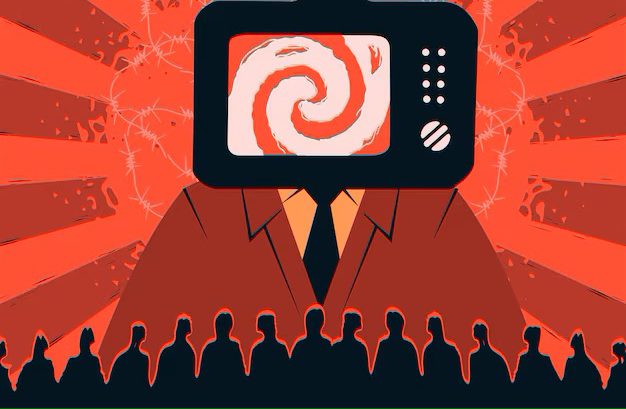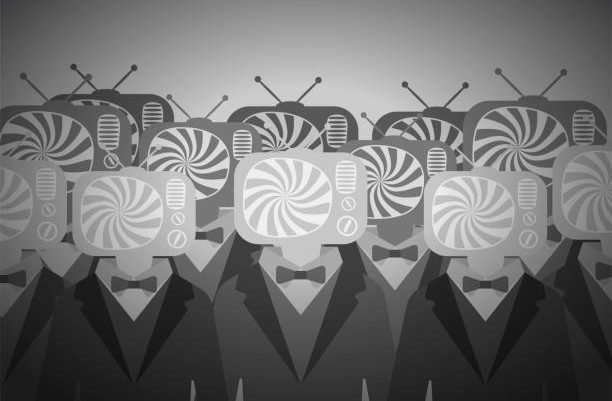RFK Jr. is pushing Big Pharma ad ban – and corporate media is panicking
Many people believe in the manipulative, con-artist advertisements for prescription drugs that are marketed on television and during streaming shows. For the past thirty years, the majority of Americans who have been brainwashed to believe in everything allopathic, including toxic jabs, think that the horrific side effects aired (super quickly) at the end of the drug commercials are “rare” and not needed to be considered.

Little do they know, most statins and weight loss drugs (which have the biggest sales in the U.S.) also contain venom peptides, GMOs, and other contaminants meant to break down the body’s vital functions. That’s why Robert F. Kennedy Jr. is pushing to ban all those ads, in an effort to make America healthy again, and Big Pharma is in a massive panic over it.
Rule of thumb – any medicine advertised on television is most likely made to quell symptoms while making you sicker
How can someone ban pharma ads on television without getting “suicided” (two bullets to the back of the head and labelled “suicide”) by the pharma goons and trolls who have billions of dollars to hire a hitman as their business would be severely affected by lack of manipulative TV ads? Not to mention the corporate media tycoons who would lose an extremely large revenue they make from airing these ads. According to Simulmedia, typically, the cost of a 30-second ad on a major U.S. national network during prime-time programming can range from $200,000 to $1 million or more (for example, during the Super Bowl). But RFK Jr. has no fear, and he is taking on Big Pharma head on, due to Trump putting him in the position to do so.
As Secretary of HHS, RFK Jr. plans to stop the madness of pharma companies running brainwashing ads on television that market deadly drugs directly to consumers, who are already dumbed-down by other prescription drugs they’re already taking, fluoride in their water, pesticides in their conventional produce, and mRNA spike prions throughout their brain.
America’s health system was in the gutter for decades and it got even worse under Biden. The whole Pharma corporate world is malignant. It’s carcinogenic. Venoms from deadly animals like snakes, scorpions, frogs and lizards are used to make humans sick with problems doctors can’t even identify properly. People get to suffer from vital organs fail, reproductive systems shut down, and worse.
TV drugs ads are designed to manipulate and coerce patients to ask their doctors for drugs that maim and kill
Notice there are no ads for healthy products endorsed by doctors. Notice there are no healthy lifestyle ads endorsed by doctors. Notice there are no ads for organic foods or supplements endorsed by doctors. Ask yourself why? Western medicine is built on making humans sick and keeping them sick. It’s a cash cow. It works in tandem with Big Food and the toxins are relentless.
Ever notice that pharma drug commercials are super loud? That’s so that when the viewer gets up to go to the kitchen to get some junk food in the commercial break of his favourite TV show, he/she can still hear the ads. Also, they emotionally manipulate the viewers by showing them horrific images of certain diseases and telling them that, unless they buy that specific drug, they may be the next person in that terrible situation.
This is how Dr. Joe Dispenza explains it, in his book Becoming Supernatural:
“While packing my bags in preparation for my afternoon flight home, I turned on the television to catch up on the political situation in the United States. I quickly surfed through the channels to find a news station, set the remote down, and while halfway paying attention to the TV, continued packing. Suddenly, a commercial came on that caught all my attention, and in an instant I understood why we call television ‘programming.’
The commercial began with a nighttime exterior shot of a couple’s home. As the camera zooms in on the house, the words “Night #14 with Shingles” appear on the screen. When the shot moves to the interior, tender yet foreboding music plays while an elderly man moans in pain at the foot of his bed. His concerned wife enters the room and asks him how he’s doing. “It hurts,” he replies. In the lower right corner in a tiny font almost the same color as the background are the words “actor portrayal.”
The wife walks over with a look of despair and slowly lifts her husband’s shirt, revealing huge, red-scabbed lesions covering more than half his lower back. The imagery is shocking, grotesque, and horrific, looking like nothing less than a large third-degree burn. In my 31 years of practice, I’ve examined hundreds of people with shingles and have never seen anything that looked so severe as the manufactured lesions in this commercial. I immediately knew it was designed to evoke a strong emotional response with the viewing audience—because it certainly did in me.

Once you see the rash on the man’s back, the commercial achieves its goal of commanding your attention. Because the portrayal of the rash is so arresting, it changes the way you were feeling from only a few moments before your present state of watching it. The moment the commercial significantly changes your internal emotional state, it causes you to put more of your attention and awareness on the source of the disruption in your external environment. The stronger the emotion it causes (stimulus), the more you lean in and pay attention (response). This association of stimulus and response, or conditioning, is how long-term, or associative, memories are created.
This process of conditioning begins by pairing a symbol or an image with a change in an emotional state—a combination that opens the doorway between the conscious and subconscious psyche. In the case of the shingles commercial, now that they have captured all your attention (and begun the programming process), you can’t help but naturally wonder what they’re about to say next.
The commercial continues with a somber male narrator: “If you’ve ever had chicken pox, the shingles virus is already inside of you. As you get older, your immune system weakens and it loses its ability to keep the shingles virus in check.” By using emotional branding, this is the first instance where the commercial raises ethical questions by telling the audience that the immune system weakens with age. Next, we see the man in the bathroom looking at himself in the mirror. He looks worried, broken, and defeated.
The scene moves to his wife talking on the phone in the kitchen. “I just can’t stand seeing him like this,” she says. Next, we see the man doubled over on his bed, palm to forehead, wincing in pain. The narrator then makes a direct suggestion, reinforced by the same words appearing on the screen: “1 in 3 people will get shingles in their lifetime.” The narrator continues while the same words remain on the screen. “The shingles rash can last up to 30 days.”
The scene cuts to his wife pleading directly into the camera: “I just wish there was something I could do to help.” Again, we see the man in pain, and on the screen appear the words: “1 in 5 people with shingles will have long-term nerve pain.” These words remain on the screen for the remaining narration, which says, “Some people with shingles will have long-term nerve pain, which can last a few months to a few years. Don’t wait until someone you love develops shingles. Talk to your doctor or pharmacist about your risk.”
Let’s take a closer look at what this commercial is attempting to do. First, it puts you in an emotional state by changing how you feel. Once it captures your attention, you immediately become more open and suggestible to the information that follows. Now that you’re more prone to accept, believe, and surrender to this information (without analysing it), if you’re feeling fearful, victimized, vulnerable, worried, shocked, weak, tired, or in pain, you’re more susceptible to the information equal to those emotions. You might start wondering if the ailment could occur to you.
At various points during the commercial, certain “facts” appear written on the screen, allowing you to read along. This serves to reinforce the programming.
Also, while the thinking brain is focused on reading the copy, the content of the narration slips behind the conscious psyche and into the subconscious psyche. Like an audio recorder, it records the entire script and creates an internal program.
Next, through a direct, literal suggestion, the narrator has instilled fear in you by personally suggesting you already have the shingles virus in your body and that because of the natural process of aging, your immune system is no longer strong enough to take care of the virus. This turns on your emotional brain (the seat of your autonomic nervous system), allowing it to become programmed.
Once the suggestions make it to your autonomic nervous system, it takes the orders without question and gets busy making chemical changes in your body equal to the literal suggestions. In other words, your body is going to subconsciously and automatically be programmed to weaken your immune function. In conclusion, you’re at risk and you’d better not wait until you contract it.
The commercial’s effect goes even a little further: if you’ve ever had chicken pox and after watching this you “think” your immune system is weak because of your age, you will decide you have an even greater need to prevent getting shingles, so you will be even more motivated to buy the drug. If you are a person who has shingles and you’re watching this commercial, when you see that your condition is not as severe as the actor’s shingles, you may find yourself thinking, “I should take the drug now so that it doesn’t get any worse. I don’t want to end up like him.” If you don’t have shingles, at the commercial’s end you may still be left quietly wondering, “Am I part of the two-thirds of the population that is safe? Or am I in the one-third of the population that will get the virus? If you think, I hope I’m not part of the one-third,” it means you believe there may be a risk that you’re susceptible and vulnerable, leaving you unconsciously thinking that you already have it.

You know what I found most absurd about this commercial? They never even mention the drug, which means they don’t have to reveal its side effects. Since the commercial had now piqued my curiosity, I stopped packing and looked on the Internet for another commercial by the same pharmaceutical company. I wanted to know what drug they were suggesting would alleviate the severity of the actor’s exaggerated, manufactured lesions.
After a quick search, I found several similar commercials with the same theme and wording but with slight variations. They all shared one aspect in common, however; they were all designed to capture your attention.
In the next commercial I watched, a woman is wearing goggles and swimming in a lap pool. Everything is black and white. In a twist on the previous commercial, the narrator (speaking in an authoritative female British accent) is the shingles virus and the narration is coming from within the woman’s head: “Impressive, Linda. Age isn’t slowing you down, but your immune system weakens as you get older, increasing the risk for me—the shingles virus. I’ve been lurking inside you since you had chicken pox. I could surface at any time as a painful blistering rash.”
The scene then abruptly cuts from black and white to color and a man lifts his shirt to reveal the worst shingles rash you’ve ever seen. Again, the grotesque, blistering lesion can’t help but attract your attention. As quickly as the scene turns to color, it returns to the swimmer in black and white.
The commercial continues in a similar manner and formula as the previous one: First make an arresting statement or show a shocking image to change the viewer’s emotional state, then cause them to be more suggestible to the information via the change in their emotional state, and finally use autosuggestion to make them wonder if they already have shingles.
This ad also infers that even though you might be healthy, active, and take care of yourself, you can still become a victim of the virus, further suggesting that no one is immune. Again, the words on the screen reinforce the message: “1 in 3 people get me in their lifetime. Linda, will it be you?” If you identify with the woman in any manner, the voice is talking directly to you.
The tone of the commercial then changes as a new male narrator begins speaking in a confident, light-hearted tone, devoid of worry or concern. In a similar British accent, the voice says, “And that’s why Linda got me—Drug X.”
The scene remains in black and white except for the woman’s bathing suit, her swim cap, and the name of the drug, which appears on the screen in a large, sophisticated font. Now the drug has been imprinted into your brain at yet another level. Once again, the ad has created an association between your health and safety and the drug that will protect you.
The tagline comes on the screen as the narrator reads it aloud, stating that the drug helps “to boost your immune system against shingles. To help protect her against you, shingles.” At the end of the commercial, that narrator says, “Drug X is used to prevent shingles in adults fifty years and older. The drug is not to be used to treat shingles, and it does not help everyone.”
Here’s the punch line: “You should not take the drug if you have a weakened immune system.”
Whoa—what? Back up. Here’s the irony: They just told you that as you age, your immune system weakens and you’re at a greater risk for shingles. The drug is supposed to strengthen your immune system, but you shouldn’t use it if you have a weakened immune system. Now comes the dilemma: If you still choose to take the drug, you believe the drug to be more powerful than your possibly weakened immune system. The programming worked.
What the shrewd, unethical, advertisers understand is that this message is confusing and disorienting to your conscious psyche. At the same time, however, they are programming your subconscious psyche with the idea that your immune system is weak, you probably already have the virus within you, and risks are high that you’ll get shingles, even if you are healthy. In addition, you are told that without the medication, you are likely to suffer—even though there is no guarantee that the shingles will go away easily—and that it still might not work if your immune system is weak.
Finally come the side effects (which are not side effects, but direct effects): “A shingles-like rash, redness, pain, itching, swelling, hard lumps, warmth, bruising or swelling at the injection site, and headache. Talk to your doctor if you plan to be around newborns or people who are pregnant or have a weakened immune system because the vaccine has a weakened version of the chickenpox virus and you could infect them.”
Wow! I started to wonder what planet I was living on. This type of programming makes you wonder if we really use our free will or if we’re all making choices based on what we have been conditioned to believe is the answer, whether that’s a certain type of juice, shampoo or conditioner, the latest smartphone, or a pill that may or may not provide relief from the shingles virus you may or may not even have.

Most of the time advertising appeals to lack and separation by reminding you to want what you don’t have, desire what you need to fit into a social environment, or satiate a feeling of emptiness or loneliness.
And of course, in this case, if you’re sick or feeling like you’re sick, the advertiser has the answer to your symptoms.
In one final search, I came across a similar commercial with the same theme —an actor dramatically suffering for 17 days, the shocking exposure of a huge lesion, and words on the screen to influence the viewer’s thoughts while reinforcing the same content. Like the other commercials, this one explicitly informs the public that the drug is not used to treat shingles, but at the end of the commercial the handsome man smiles and declares, “I think I’m going to give it a try.” Meanwhile, I’m left wondering why he would give it a try if he already has had shingles for 17 days, especially if the drug doesn’t treat the condition.
Now I’m really confused.
Years ago, I learned in my training that by definition, hypnosis is a disorientation of the inhibitory processes of the conscious psyche, bypassing the analytical psyche so that one becomes highly responsive to suggestions and information in the subconscious psyche. As the conscious psyche is busy and preoccupied with reasoning and analysing, the subconscious psyche takes it all in without discretion. If one can disorient people with information (or in today’s world, disinformation), shock, or confusion, one just opened the door to programming their subconscious psyche.”
It is worth noting that such insidious manipulation by Big Pharma does not occur in U.S. alone – it is very likely that you see it/ hear it on your television, radio, online media every day, no matter in what part of the world you live.
yogaesoteric
April 4, 2025
